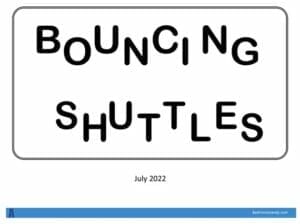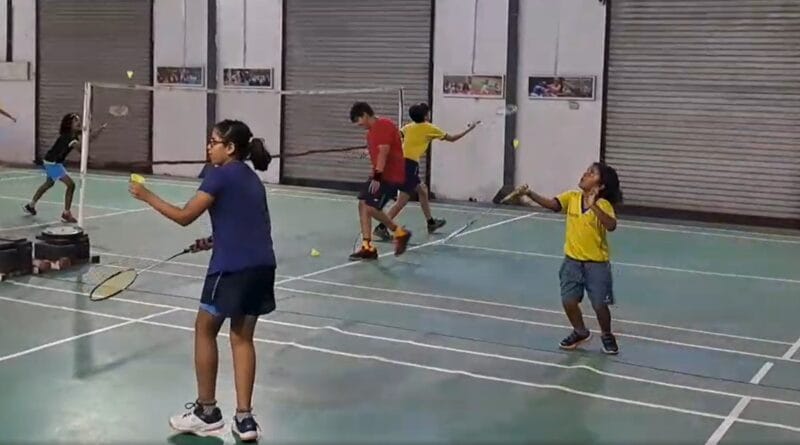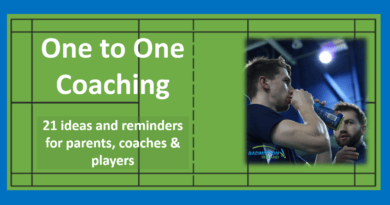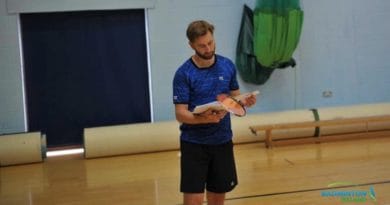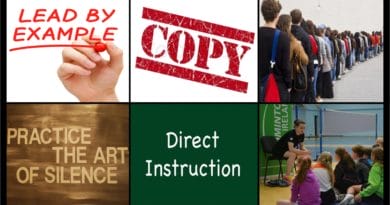Bouncing shuttles – working with young beginner players
How do you ensure that beginner players get the best start?
It is possible to introduce lots of early foundational techniques just by bouncing shuttles
I recommend that you follow these tips and see for yourself
‘Bouncing Shuttles’, is much more than just bouncing shuttles
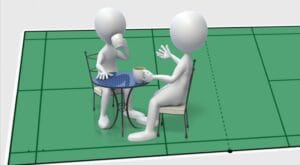
These ideas came after talking with a coach who wanted to know what early practices they could do with very young players. Especially in the first 12 weeks of experiencing badminton. They were interested as to why I like bouncing shuttles in practice.
The coaching wanted something that would not only keep them busy but also start developing traits that would help future development and coaching. They wanted early practices/tasks/challenges they could do with their players.
This topic and many other questions and conversations with coaches have inspired me to create a section on the site called ‘Courtside Conversations’. There are snippets of conversations with coaches, hopefully, you’ll find something interesting ????
– – – – – – – – – – – – – –
Why use this practice
The early foundational skills
Advice for the coach
The challenges & practices – your download
– – – – – – – – – – – – – – – –
1. Why use this practice
I believe that this is an essential practice for all young beginner players when they first experience badminton. One of a few important experiences for them to have.
Will bouncing shuttles make them a great player, who knows, but that is NOT the aim.
However, will bouncing shuttles allow players to experience some early essential aspects of our sport and how skills develop, yes, certainly it will
Players will experience (and hopefully like)
- Enjoyment from task success – motivation and ‘thirst’ for engagement is a priority, mixed with a challenge (success & struggle)
- Progressive challenges – all set at a success expectancy level of 70-80% after a short exposure, “I want to try the next task!”
- Frequent interaction with the setting of tasks – players unknowingly talking part in progressive practice design
Coaches will experience (and hopefully like)
- The setting of progressive practices – having to identify challenge levels and ‘chunking’ of progressions
- Demonstration with reduced technical content – this will should be the primary way of setting practice tasks and require coach thought
- Creating practical easy to understand instructions – challenging coaches to reduce the requirement for complex tasks/instructions
Intentional practice masked as fun tasks & challenges is the aim of this practice
( this could be said to be the aim of many practices 🙂 )
– – – – – – – – – – – – – – – –
2. The early foundational skills & techniques
It is an opportunity to develop some early technical and psychological skills.
Do you agree with these suggestions and have you experienced how easily they can be incorporated into the practice of bouncing shuttles?
Skills
- The acceptance and desire to have progressive challenging practices – “behind every mountain is another mountain!”
- The ability to master a task using previously learnt techniques
- A desire to take part in the setting of practice and challenge level
- Understanding that errors can be used as an aid to development and are sometimes initially expected
Techniques
- Striking at a comfortable range around arm-pit level
- Moving with wider legs and racket leg forwards
- Holding with a sideways grip that enables both FH and BH striking with limited grip adjustments
- The generation of power using flicking techniques involving the hand and fingers
Engage players in a fun challenging progressive practice and
ensure that some underpinning skills/techniques are at least partly established
– – – – – – – – – – – – – – – –
3. Advice for the coach
I’ve heard coaches state that the first sessions should be fun and not contain much ‘coaching’. I’ve also heard coaches say that the first sessions should specifically address certain strokes (BH net shot, BH serve, even FH overheads).
This variation of opinion can be confusing to the new coach. My thoughts are …
- Whatever beginner players do, they will have an experience of our sport – so why not at least have some control over what they experience
- Just because the session is planned does not mean that it has to be ‘traditional’ highly instructional coaching – this type of coaching may not be the most effective anyway
- If the session is carefully planned can there ever be a question of too much coaching – again this points to a lack of knowledge concerning practice design
- Constraining and guiding practice is effective – as a minimum, it can reduce the opportunities for critical ineffective (or limiting) techniques from developing
- Good or near correct patterns can be improved but some imperfect techniques seem to stay around no matter what you do to remove them. Therefore coach should think hard about a player’s early experiences
Coaches should aim to ..
- Have the motivation and desire of players at the heart of all the bouncing practices, practice will flow and be enjoyable for both player and coach
- Vary the context of the practice and design both Errorful and Errorless practice. Challenge and success levels must vary
- Ensure that there is a progression in all aspects. The rate of progression is not the aim, however, glimpses of development is.
- Develop a reductive style in the delivery of technical information and task instruction
– – – – – – – – – – – – – – – –
4. The challenges & practices – your download
I’ve gathered up 17 different practices for you to use. Click on the image below to download
It’s now your challenge to consider how to introduce each and to create mini variations within each. There is no rush to progress through them, I recommend that you take plenty of time and many lessons.
Please let me know what tips and tricks you use 🙂
